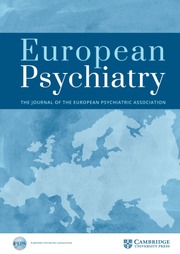Article contents
Social anxiety disorder and temperament: Excitatory and inhibitory mechanisms on primary motor cortex in patients and healthy controls
Published online by Cambridge University Press: 16 April 2020
Abstract
Neurofunctional imaging studies comparing subjects with SAD and NC, reported a consistent increases in amygdala, changes in the lateral paralimbic regions and occipital cortices.
A current hypothesis underlying pathophysiology of social anxiety involves the dopaminergic system: SAD Subjects sow a reduction in D2 striatal binding (Schneier et al., 2000; Tihonen 1997)We hypothesized that subjects with SAD may have an altered cortical excitability, given previous imaging results showing changes in cortical activity. We also aimed to verify if SAD patients show at TMS a pattern Parkinson-like.
In order to highlight if there was a correlation between the temperamental dimensions and the measured parameters in our sample, we also explored the temperament of patients and HCs.
We recruited n=15 SAD subjects and n=11 NC. We have utilized TMS on Primary Motor Cortex (M1) in order to study neuronal excitability and cortical inhibitory mechanisms. These has been achieved by examining EMG recording Motor Evoked Potentials (MEP). We measured MEP, Motor threshold, Cortical Silent Period (CSP), paired pulse inhibition both in patients and healthy controls. Clinical assessment was conducted with the MINI interview, Liebowitz Social Phobia Scale, TPQ
neurophysiological variables are not significantly different between groups. Patients with SAD showed a significantly higher Harm Avoidance and lower Novelty Seeking. There was a positive correlation between CSP and Novelty seeking and a negative correlation between LICI and Novelty Seeking among patients but not among HCs
Information
- Type
- Poster Session 2: Anxiety, Stress Related, Impulse and Somatoform Disorders
- Information
- European Psychiatry , Volume 22 , Issue S1: 15th AEP Congress - Abstract book - 15th AEP Congress , March 2007 , pp. S284
- Copyright
- Copyright © European Psychiatric Association 2007
- 1
- Cited by


Comments
No Comments have been published for this article.